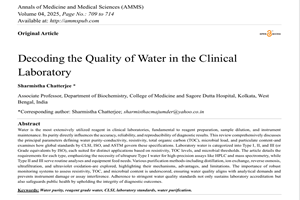##plugins.themes.bootstrap3.article.main##
Abstract
Water is the most extensively utilized reagent in clinical laboratories, fundamental to reagent preparation, sample dilution, and instrument maintenance. Its purity directly influences the accuracy, reliability, and reproducibility of diagnostic results. This review comprehensively discusses the principal parameters defining water purity-conductivity, resistivity, total organic carbon (TOC), microbial load, and particulate content-and examines how global standards by CLSI, ISO, and ASTM govern these specifications. Laboratory water is categorized into Type I, II, and III (or Grade equivalents by ISO), each suited for distinct applications based on resistivity, TOC levels, and microbial thresholds. The article details the requirements for each type, emphasizing the necessity of ultrapure Type I water for high-precision assays like HPLC and mass spectrometry, while Type II and III serve routine analyses and equipment feed needs. Various purification methods-including distillation, ion exchange, reverse osmosis, ultrafiltration, and ultraviolet oxidation-are explored, highlighting their mechanisms, advantages, and limitations. The importance of robust monitoring systems to assess resistivity, TOC, and microbial content is underscored, ensuring water quality aligns with analytical demands and prevents instrument damage or assay interference. Adherence to stringent water quality standards not only sustains laboratory accreditation but also safeguards public health by upholding the integrity of diagnostic outcomes.
##plugins.themes.bootstrap3.article.details##
Copyright (c) 2025 Sharmistha Chatterjee

This work is licensed under a Creative Commons Attribution 4.0 International License.
Creative Commons License All articles published in Annals of Medicine and Medical Sciences are licensed under a Creative Commons Attribution 4.0 International License.
[1] Clinical and Laboratory Standards Institute (CLSI). Preparation and Testing of Reagent Water in the Clinical Laboratory; Approved Guideline - Fourth Edition. CLSI document C3-A4. Wayne, PA: CLSI; 2011.
[2] American Society for Testing and Materials (ASTM). Standard Specification for Reagent Water. ASTM D1193-06; 2011.
[3] Burtis CA, Ashwood ER, Bruns DE. Tietz Fundamentals of Clinical Chemistry and Molecular Diagnostics. 5th ed. Philadelphia: Elsevier; 2012. p. 209–211.
[4] McPherson RA, Pincus MR. Henry’s Clinical Diagnosis and Management by Laboratory Methods. 22nd ed. Philadelphia: Elsevier; 2011.
[5] National Institutes of Health, Division of Technical Resources. Laboratory Water: Its Importance and Application. Bethesda, MD: NIH; March 2013.

